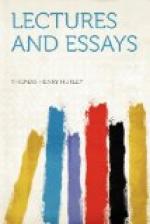These are the Pterosauria, or Pterodactyles, the remains of which are met with throughout the series of Mesozoic rocks, from the lias to the chalk, and some of which attain a great size, their wings having a span of eighteen or twenty feet. These animals, in the form and proportions of the head and neck relatively to the body, and in the fact that the ends of the jaws were often, if not always, more or less extensively ensheathed in horny beaks, remind us of birds. Moreover, their bones contained air cavities, rendering them specifically lighter, as is the case in most birds. The breast-bone was large and keeled, as in most birds and in bats, and the shoulder girdle is strikingly similar to that of ordinary birds. But it seems to me that the special resemblance of pterodactyles to birds ends here, unless I may add the entire absence of teeth which characterises the great pterodactyles (Pteranodon) discovered by Professor Marsh. All other known pterodactyles have teeth lodged in sockets. In the vertebral column and the hind-limbs there are no special resemblances to birds, and when we turn to the wings they are found to be constructed on a totally different principle from those of birds.
There are four fingers. These four fingers are large, and three of them, those which answer to the thumb and two following fingers in my hand—are terminated by claws, while the fourth is enormously prolonged and converted into a great jointed style. You see at once, from what I have stated about a bird’s wing, that there could be nothing less like a bird’s wing than this is. It was concluded by general reasoning that this finger had the office of supporting a web which extended between it and the body. An existing specimen proves that such was really the case, and that the pterodactyles were devoid of feathers, but that the fingers supported a vast web like that of a bat’s wing; in fact, there can be no doubt that this ancient reptile flew after the fashion of a bat.
Thus, though the pterodactyle is a reptile which has become modified in such a manner as to enable it to fly, and therefore, as might be expected, presents some points of resemblance to other animals which fly; it has, so to speak, gone off the line which leads directly from reptiles to birds, and has become disqualified for the changes which lead to the characteristic organisation of the latter class. Therefore, viewed in relation to the classes of reptiles and birds, the pterodactyles appear to me to be, in a limited sense, intercalary forms; but they are not even approximately linear, in the sense of exemplifying those modifications of structure through which the passage from the reptile to the bird took place.
III
THE DEMONSTRATIVE EVIDENCE OF EVOLUTION
The occurrence of historical facts is said to be demonstrated, when the evidence that they happened is of such a character as to render the assumption that they did not happen in the highest degree improbable; and the question I now have to deal with is, whether evidence in favour of the evolution of animals of this degree of cogency is, or is not, obtainable from the record of the succession of living forms which is presented to us by fossil remains.




